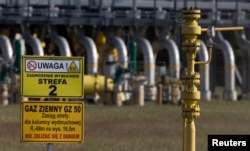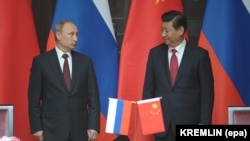In the European Union this winter, fears of rolling blackouts triggered by Russian energy export cuts amid Moscow’s war in Ukraine have subsided thanks to good luck, good weather, and quick action.
A warm start to the heating season in October and November enabled the EU to slash natural gas consumption and store more fuel for the winter months. Meanwhile, slumping Chinese demand due to COVID lockdowns allowed liquefied natural gas (LNG) tankers bound for Asia to be rerouted to the bloc.
EU officials also played a role, encouraging countries to cut consumption, improve efficiency, and boost alternative energy supplies to help offset the drop in supply.
But luck can run both ways. A reversal of this year’s fortunes, combined with further natural gas export cuts by Russia, could leave Europe with insufficient energy supplies and skyrocketing prices next winter, analysts say.
“If pipeline imports to the European Union from Russia drop to zero in 2023 and Chinese LNG demand rebounds to 2021 levels, then the European Union faces a serious supply-demand gap opening up in 2023,” the International Energy Agency (IEA) said in a December 12 report.
“In the short run, Europe is in a difficult predicament,” Agathe Demarais, the global forecasting director at the Economist Intelligence Unit, wrote in Politico in November, adding that the situation could worsen next winter.
“But in the long run, Russia simply can’t win this energy war,” she wrote.
The IEA estimated that the EU gas deficit in 2023 could be as high as 57 billion cubic meters (bcm), or nearly 15 percent of its forecast demand, though it said measures currently being implemented -- such as new solar and wind projects -- should cut the shortfall to 27 bcm.
The EU could cover the remaining gap if it immediately invests an additional 100 billion euros ($107 billion) to expand alternative energy projects and boost energy efficiency, the IEA estimated.
Natural gas is largely used to heat homes and buildings, fuel power plants, and run industrial processes, such as the production of fertilizers. A shortfall would lead to high and volatile energy prices in the EU, triggering industrial and household demand destruction and energy rationing.
Some nations have already put contingency plans in place should a crisis arise.
Much depends on what the Kremlin does -- or doesn’t -- do.
From 60 To Zero
Russia had been the largest supplier of natural gas to the European Union, accounting for nearly 40 percent of the bloc’s demand in 2021, giving Moscow enormous leverage over the EU’s energy sector.
And it was quick to use that power after unleashing its massive invasion of Ukraine in February, seeking to undermine Western unity and support for Kyiv by sharply curtailing gas exports to the bloc and driving prices to record highs.
Russian natural gas exports to the EU via pipeline are forecast to fall to about 60 bcm this year compared with 140 bcm last year and nearly 200 bcm in the pre-Covid year of 2019.
Despite the worst relations in decades between Moscow and the West, Russia is still supplying the EU with gas via pipelines that run through Ukraine and Turkey while also shipping LNG to the bloc.
But the Russian pipeline exports may be further curtailed or stopped altogether in 2023, some experts fear, forcing Europe to hunt for gas in a world with limited options.
Russia is currently supplying about 25 bcm on an annualized basis to the EU, according to the IEA. About two-thirds of that comes via Ukraine, where fierce fighting continues.
“With the Ukrainian pipeline, I think there is a risk of either accidental damage or intentional damage,” Nadia Kazakova, an analyst at Renaissance Energy Advisors in London, told RFE/RL.
She said Russian exports via Turkey should continue unless the Kremlin determines that a complete shutdown of pipeline gas to the EU is politically and militarily expedient.
“They will keep pumping until they go all-out in Ukraine,” she said.
Chris Weafer, a Russia energy expert at the Moscow-based Macro Advisory, said he doesn’t expect Russia to cut gas volumes to Europe any further because it needs the cash and can’t sell the pipeline gas to other markets due to a lack of infrastructure.
Russia earned bumper export revenues during 2022 as commodity prices surged but the money has largely gone toward financing the war, now in its 11th month with no end in sight.
And the outlook for Moscow’s export revenue in 2023 looks substantially worse. Oil, Russia’s main export commodity, has already tumbled from a high of $130 reached in March to just above $80, near a one-year low.
Russia is selling its oil at a sharp discount to market price due to Western sanctions.
Game Of Chicken?
Exports of oil and refined products made up about 34 percent of Russia’s federal budget revenue this year, with gas accounting for about 10 percent, according to Elina Ribakova, an economist at the Washington-based Institute of International Finance.
Russia is expected to post back-to-back budget deficits in 2022 and 2023 of around 2 percent, forcing the Kremlin to tap its so-called “rainy day” fund to cover the shortfall.
Russia “will need at least current gas export volumes because it will need to try and keep the budget deficit as low as possible,” Weafer told RFE/RL.
But the reliance still cuts both ways, at least for now.
Europe and Russia “have managed to reduce gas dependency on the other this year but volumes are now down to critical levels,” Weafer said. “Neither can afford for gas volumes from Russia to Europe to drop any further in 2023, and probably also 2024.”
The EU actually imported more Russian LNG in 2022 than the previous year as it struggled to find alternatives to Russian pipeline gas.
“LNG from Russia is politically more acceptable to Europe...it allows Brussels to say it has options and not stuck with Russian risk. The reality is not so clear,” Weafer said.
The EU largely covered the Russian gas shortfall of 80 bcm by importing more LNG from the United States and Middle East, switching to coal, and enhancing energy conservation.
However, surging energy prices did cause about 10 bcm of industrial demand destruction, the IEA said.
LNG Competition With China
To offset the drop in Russian pipeline gas, the EU imported about 50 bcm more of LNG in 2022. That would have been a lot harder to do had China not locked down its economy to combat COVID.
China more than tripled its purchases of LNG from 2016 to 2021, making it the world’s largest importer of the fuel last year. It had been forecast to import even more in 2022, but the lockdowns ended up slicing demand by 20 bcm, allowing LNG cargoes to be rerouted to the EU.
Europe may not be so lucky in 2023. China has eased its lockdowns and its demand for LNG could return to 2021 levels, leading to competition with Europe for spot cargos, experts say.
“We could see Europe struggling to attract enough volumes of LNG to refill the storages ahead of next winter,” Carlos Diaz, an analyst at the Oslo-based Rystad Energy, told RFE/RL.
To make matters worse, there will be little growth in non-Russian pipeline or LNG supplies in 2023, Diaz said.
Norway, Azerbaijan, and the countries of North Africa -- key exporters of pipeline gas to the EU -- are already operating at or near capacity, he said. And the United States and Qatar won’t launch major new LNG export projects for another two years.
The EU could offset some natural gas demand in 2023 with an increase in hydropower production, but hopes that nuclear power would also rebound may not materialize, Diaz said.
EU consumption is heavily weather-dependent, he said, so how tough things will be next winter also depends on how warm or cold the rest of the current winter will be.
The EU had high storage levels of natural gas coming into December thanks to an unusually warm autumn, though a short-lived cold snap later in the month did cut those reserves.
The lower the gas storage levels are come spring, the more fuel the EU will have to purchase in a supply-constrained market to prepare for the winter of 2023-24, he said.
Should the rest of the winter season turn out “normal,” then the EU will exit the heating season with sufficient volumes in storage, “making it easier to refill to a comfortable level by the start of next winter,” he said. If it's colder than normal, then the EU could still be in for a rocky ride.
“We still have three months of winter to go and storage levels have started to deplete at a fast rate, so it's still not certain that this winter will be as comfortable as some have now come to expect,” Diaz said on December 20.
'Gas Suicide'
In any case, though, analysts say that, while the EU may suffer in the short-term from the reduction of energy supplies due to the Brussels-Moscow showdown over the invasion of Ukraine, Russia is set to lose in the long-term.
“Moscow’s blackmail has, once and for all, convinced EU countries that Moscow isn’t a reliable energy supplier,” Demarais wrote. As Europe steps up efforts to drop its dependence on Moscow, “it’s starting to look like, within three years or so, Europe won’t need Russian oil and gas anymore.”
It’s a momentous change that could hardly have been predicted before Putin launched the large-scale invasion of Ukraine on February 24, even after years of tension between Moscow and the West.
“Russia’s gas business in Europe…is now all but dead,” Thane Gustafson, a professor at Georgetown University and author of several books on Russia’s energy industry, wrote in a December 12 blog post.
Russia has been exporting gas to Europe since the 1960s and the symbiotic relationship survived both the depths of the Cold War, the breakup of the Soviet Union in 1991, and Moscow’s rocky transition to a market economy.
By the 2000s, Russia’s position as the leading supplier of natural gas to Europe seemed assured for decades to come. Putin, who took power at the end of 1999, had agreed to invest more than $200 billion to develop new natural gas projects on Yamal Peninsula in the Far North for export to Europe.
To get the gas to market while avoiding transit through Ukraine, he ordered the construction of several new export pipelines, including Nord Stream 1 and 2 to Germany and TurkStream to Turkey.
Those investments helped Russia generate annual European gas export revenues of more than $50 billion in recent years. With European domestic gas production falling, Russia looked set to continue to reap a windfall from gas exports to the EU.
“European gas demand was projected to keep growing for at least another decade,” Gustafson wrote -- but Putin’s decision to launch an invasion of Ukraine and his subsequent cutoff of gas exports to Europe has “dashed” the EU’s trust in the Kremlin “for a generation.”
The war has accelerated Europe’s transition away from fossil fuels to cleaner alternatives with the result that in five years’ time, Turkey will remain the “sole buyer” of Russian gas in Europe, he said.
“The final result is clear…. Putin has not simply committed gas suicide,” Gustafson wrote. “He has killed off the last half-century of entente along with it."















